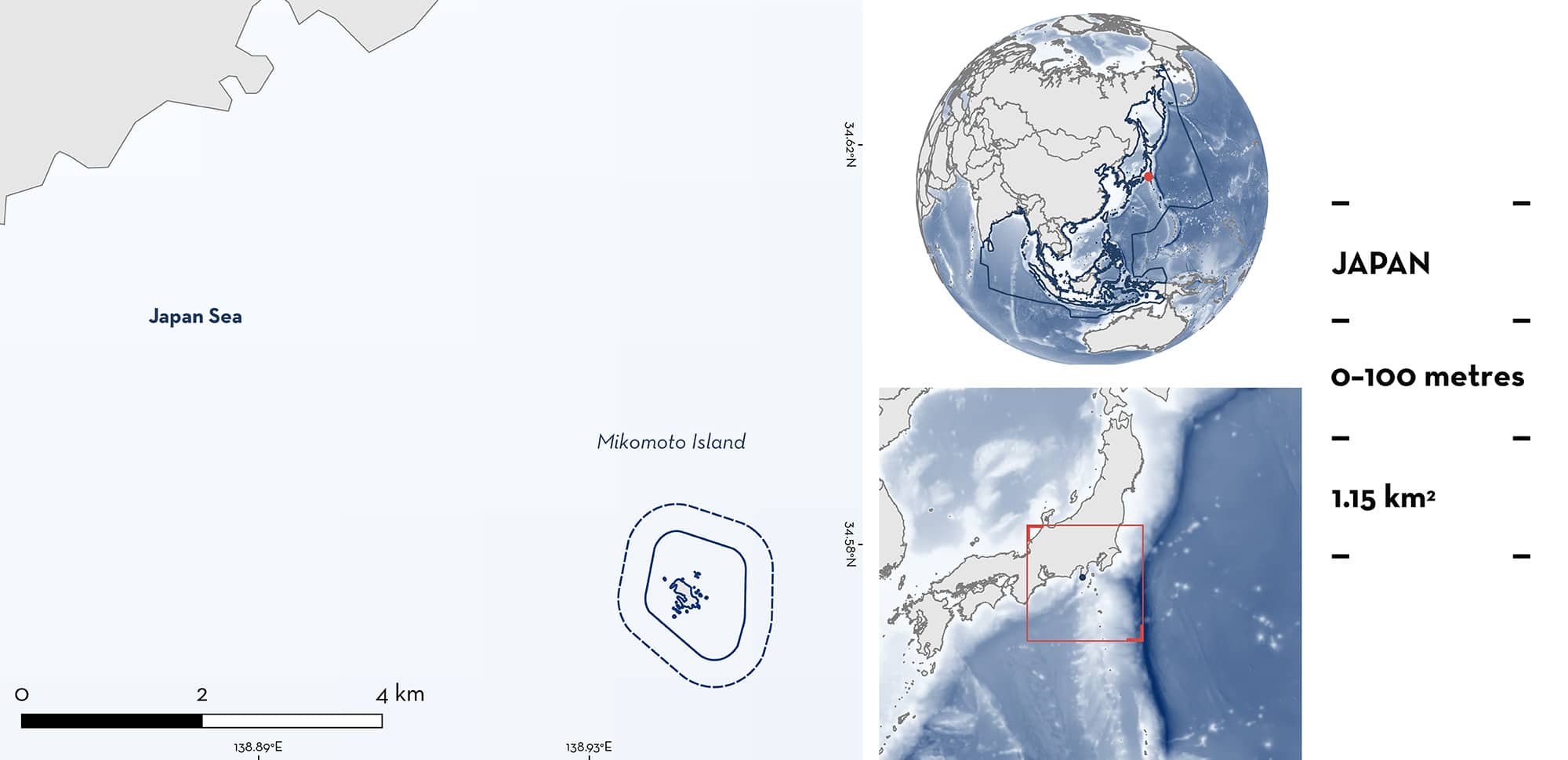ISRA FACTSHEETS
ISRA FACTSHEETS
ASIA REGION
Mikomoto Island
Summary
Mikomoto Island is located 10 km southeast of the Izu Peninsula and ~250 km west of the Japan Trench in Japanese waters. The island rises vertically from 2,500 m deep to 10 m above sea level. The area encompasses hard rock and boulders, with limited subaquatic vegetation due to the strong Kuroshio Current which passes over the seamount. This area falls within Fuji Hakone Izu National Park, Southern Coastal Areas of Shikoku and Honshu Islands Ecologically or Biologically Significant Marine Area, and Northern Izu Islands – Marine Key Biodiversity Area. Within this area there are: threatened species and undefined aggregations (Scalloped Hammerhead Sphyrna lewini).
Download factsheet
Mikomoto Island
DESCRIPTION OF HABITAT
Mikomoto Island is located 10 km southeast of the Izu Peninsula and ~250 km west of the Japan Trench in Japanese waters (Jacoby et al. 2022). The island rises vertically from 2,500 m deep to 10 m above sea level, whereby the ~0.7 km2 rock island is situated in the middle of an elevated depth contour of 30–40 m in all directions (Jacoby et al. 2022).
The subsurface topography is composed of hard rock and boulders with limited subaquatic vegetation or algal cover due to the strong Kuroshio Current (Jacoby et al. 2022). The Kuroshio Current is one of the western boundary currents of the subtropical North Pacific, which originates in the east of Philippines, and moves northward along the west boundary of the Pacific Ocean (Zhang et al. 2012). This current is one of the most important routes for poleward heat transport, contributing to the development of rich marine ecosystems along coastal regions. The Kuroshio Current undergoes significant spatial and temporal variability along its route, greatly influencing biological resource availability off southwest Japan (Lizarbe Barreto et al. 2012; Andres et al. 2015; Morioka et al. 2019).
The area falls within the Fuji Hakone Izu National Park (Ministry of Environment, Government of Japan 2024), Southern Coastal Areas of Shikoku and Honshu Islands Ecologically or Biologically Significant Marine Area (CBD 2024), and Northern Izu Islands – Marine Key Biodiversity Area (KBA 2024).
This Important Shark and Ray Area is benthopelagic and is delineated from inshore and surface waters (0 m) to 100 m based on the occurrence of the Qualifying Species in the area.
CRITERION A
VULNERABILITY
The one Qualifying Species within the area is considered threatened with extinction according to the IUCN Red List of Threatened Species. The Scalloped Hammerhead is assessed as Critically Endangered (Rigby et al. 2019).
CRITERION C
SUB-CRITERION C5 – UNDEFINED AGGREGATIONS
Mikomoto Island is an important aggregation area for one shark species.
Scalloped Hammerheads aggregate seasonally during the boreal summer and autumn in large numbers around Mikomoto Island seamount. Based on observations from the diving community in the area, Scalloped Hammerheads are reliably observed aggregating in groups of more than 10 individuals and up to hundreds regularly and predictably between August and September each year (Mikomoto Hammers 2024; Jacoby et al. 2022). A local dive operator has maintained a publicly available dive-log with digital photos of hammerhead observations from 2003 to 2024 (Mikomoto Hammers 2024). Based on diver observations, the animals are large bodied, measuring an estimated 210–280 cm total length (TL; with a 40 cm TL error) (Jacoby et al. 2022). Additionally, four females were acoustically tagged in August 2015, and monitored for a period of up to 363 days using an array of six receivers around the island. Data analyses showed high seasonal residency predominantly from August to November (25,779 detections) associated with lower chlorophyll-a concentrations, before sharks leave the island and return the following summer. Residency for Scalloped Hammerheads were highest among those receivers most influenced by the Kuroshio Current at the southwest of the island, which produces strong coastal upwelling (Jacoby et al. 2022). Additional information is required on the nature and function of these aggregations.
Download factsheet
SUBMIT A REQUEST
ISRA SPATIAL LAYER REQUEST
To make a request to download the ISRA Layer in either a GIS compatible Shapefile (.shp) or Google Earth compatible Keyhole Markup Language Zipped file (.kmz) please complete the following form. We will review your request and send the download details to you. We will endeavor to send you the requested files as soon as we can. However, please note that this is not an automated process, and before requests are responded to, they undergo internal review and authorization. As such, requests normally take 5–10 working days to process.
Should you have questions about the data or process, please do not hesitate to contact us.


